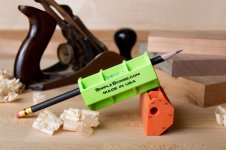My recent project has called for me to scribe quite long distances (around 2 meters) of 18mm birch plywood to the wall. The wall is painted plastered brick.
I find that if I do not scribe, then the gaps between the panel and the wall can be quite large 2mm-4mm). When I scribe (using a Fastcap Accuscribe and cutting using a Festool Carvex) I get a better fit, but still have gaps of 1mm -2mm, which tempts me to just throw some filler at it and run my finger down (which sort of defeat the point of scribing).
Are there any hints that people have on how to get better fit, apart from more practice?
Thanks!
I find that if I do not scribe, then the gaps between the panel and the wall can be quite large 2mm-4mm). When I scribe (using a Fastcap Accuscribe and cutting using a Festool Carvex) I get a better fit, but still have gaps of 1mm -2mm, which tempts me to just throw some filler at it and run my finger down (which sort of defeat the point of scribing).
Are there any hints that people have on how to get better fit, apart from more practice?
Thanks!

